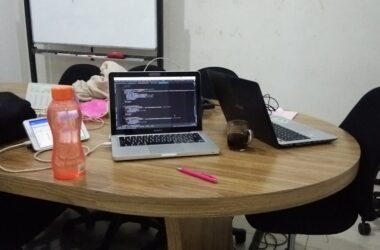Due in large part to technological advancements, project management has changed dramatically in today’s fast-paced world. In order to improve productivity, communication, and project results overall, IT augmentation is the integration of different technological tools and systems into project management procedures. It’s similar to having an enhanced toolkit that enables teams to work more efficiently rather than more laboriously. By utilizing IT solutions, businesses can increase collaboration, optimize workflows, and make data-driven decisions that result in successful project completion.
Key Takeaways
- IT augmentation in project delivery enhances efficiency and productivity.
- Streamlining project management processes with IT tools improves communication and collaboration.
- Leveraging data analytics enables informed decision making in project delivery.
- Automation and AI improve efficiency and productivity in project delivery.
- IT augmentation helps in mitigating risks and challenges in project delivery.
Effective project management is becoming even more important as companies deal with rising demands and shorter timelines. One method for addressing these issues head-on is IT augmentation. Teams can use it to communicate easily across platforms, automate tedious tasks, and analyze data in real time. In addition to saving time, this lowers the possibility of mistakes and misunderstandings. By optimizing workflows, fostering teamwork, utilizing data analytics, increasing productivity, guaranteeing quality, and reducing risks, IT augmentation can revolutionize project delivery.
Manual labor is frequently required for traditional project management, from resource management to progress tracking. Project managers can concentrate on more strategic work by automating these procedures with the correct IT tools. For example, teams can use project management software to assign tasks, make timelines, & track progress in real time. This indicates that everyone is in agreement and understands how their efforts fit into the larger project objectives. Also, IT augmentation can assist in removing bottlenecks that frequently cause project completion to lag.
Team members can access project information from any location by utilizing cloud-based platforms, which facilitates communication and update sharing. In today’s remote work environment, where teams may be dispersed across multiple locations, this flexibility is especially crucial. When project managers have access to IT tools, they can promptly spot problems and reallocate resources as necessary, keeping projects on schedule and within budget.
The foundation of a successful project delivery is effective communication. Projects function more efficiently when team members can quickly exchange updates and ideas. IT augmentation improves communication by offering a range of tools that make teamwork easier. For instance, team members can communicate in real time, no matter where they are physically located, using video conferencing platforms and instant messaging applications.
This immediacy keeps everyone interested and promotes a sense of teamwork. Also, several people can work on the same file at once thanks to collaborative platforms like shared document editors. In addition to expediting the editing process, this guarantees that everyone has access to the most recent data. Teams can collaborate more successfully by removing obstacles to communication & encouraging teamwork thanks to IT augmentation. Better decisions are made and the project eventually succeeds when everyone is on the same page and knowledgeable.
One of the most important resources a company can have in the information age is data. Throughout the project lifecycle, IT augmentation enables organizations to use data analytics to make well-informed decisions. Through the collection & analysis of data from multiple sources, project managers can acquire knowledge about potential risks, resource allocation, and performance metrics. With this data-driven approach, teams can spot patterns and make changes before problems get out of hand. Data analytics can assist in identifying the reason behind a project’s delay, such as a lack of resources or a particular task taking longer than anticipated.
Project managers can take proactive measures to resolve the problem and maintain the project’s timeline armed with this knowledge. Also, teams can anticipate possible problems and create plans to address them before they materialize by employing predictive analytics. The complex project environments of today greatly benefit from this degree of foresight. Automation and artificial intelligence (AI) are revolutionizing project delivery in terms of productivity and efficiency. Teams can use the time saved by automating repetitive tasks, like data entry or status reporting, to focus on high-priority tasks.
For instance, without requiring human input, automated reporting tools can produce progress updates, freeing up project managers to concentrate on strategic planning rather than administrative duties. By offering wise insights and suggestions based on past data, artificial intelligence (AI) also significantly contributes to increased productivity. In order to recommend the best way to allocate resources or spot possible obstacles before they become serious problems, AI algorithms, for example, can examine the performance of previous projects.
By reducing downtime & increasing output, this not only expedites decision-making but also aids teams in operating more effectively. ensuring both quality and consistency. IT augmentation offers tools for monitoring progress & upholding standards throughout the project lifecycle, which helps guarantee quality and consistency in deliverables.
For example, teams can use quality management software to monitor adherence to internal policies or industry standards & set benchmarks. Feedback and revisions in real time. Also, utilizing collaborative platforms enables real-time feedback & revisions, assisting in the maintenance of high-quality outputs. Better outcomes are achieved when team members can readily share their work & solicit feedback from one another. Quality Assurance: Improving Reputation.
Organizations can improve their reputation for providing dependable goods or services by incorporating quality assurance procedures into the project management framework using IT tools. Increased client happiness and loyalty may follow, which could eventually result in business expansion. Each project has a unique set of risks and difficulties, but IT augmentation offers resources that can successfully reduce these problems.
Teams can detect possible hazards early on and create proactive plans to deal with them thanks to risk management software. Through the examination of past data and present project metrics, teams are able to determine the probability of different risks materializing and prioritize their responses appropriately. IT tools also make it possible for stakeholders and team members to communicate risks more effectively. A transparent and accountable culture is promoted when everyone is aware of potential difficulties and their ramifications. In addition to assisting in risk management, this cooperative approach enables teams to quickly adjust to unforeseen problems.
In conclusion, adopting IT augmentation in project delivery has many advantages that can greatly improve project management for businesses. Technology is essential for achieving success, from optimizing workflows and enhancing communication to using data analytics to make well-informed decisions. Adopting these technological solutions will be crucial for businesses to remain competitive as they continue to navigate an increasingly complex environment. In the end, IT augmentation enables groups to operate more productively while upholding strict quality and consistency requirements for their outputs. Organizations may make sure they are prepared to face any obstacles by reducing risks and encouraging cooperation with cutting-edge technologies.
Accepting these developments will be essential to future project success as we enter a time when technology is still developing quickly.
In a related article on code readability, the importance of writing clean and understandable code is discussed. Just as IT augmentation can improve project delivery by streamlining processes and increasing efficiency, writing readable code can also have a positive impact on project outcomes. By ensuring that code is easy to understand and maintain, developers can work more effectively and collaborate more efficiently, ultimately leading to better project delivery.
Hire Expert Developer in 1 Day
FAQs
What is IT augmentation?
IT augmentation refers to the practice of supplementing a company’s internal IT resources with external expertise, technology, or services to enhance its capabilities and capacity.
How does IT augmentation impact project delivery?
IT augmentation can positively impact project delivery by providing access to specialized skills, knowledge, and resources that may not be available internally. This can lead to improved efficiency, faster delivery, and higher quality outcomes.
What are some examples of IT augmentation in project delivery?
Examples of IT augmentation in project delivery include outsourcing specific IT tasks or functions, utilizing external consultants or contractors for specialized expertise, and implementing new technologies or tools to enhance project management and execution.
What are the benefits of IT augmentation on project delivery?
The benefits of IT augmentation on project delivery include increased flexibility, scalability, and access to specialized expertise, as well as improved efficiency, cost-effectiveness, and the ability to meet project deadlines and objectives.
What are the potential challenges of IT augmentation on project delivery?
Challenges of IT augmentation on project delivery may include integration issues with existing systems, potential security and privacy concerns, and the need for effective communication and collaboration between internal and external teams.








